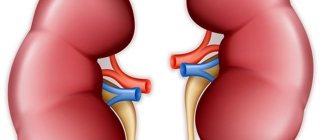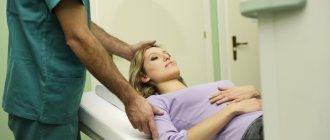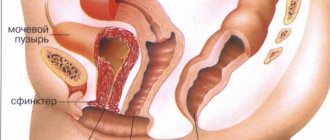Bladder exstrophy is a severe congenital pathology of the urinary system, in which the organ is located not inside the abdomen, but outside. It occurs in one in 50,000 newborns. This pathology is diagnosed four times more often in boys than in girls. Surgery is effectively used to eliminate it.
Bladder exstrophy in children, what is it?
Bladder exstrophy is a congenital pathology in which the child has not formed the anterior wall of the bladder (UB), as well as part of the anterior wall of the peritoneum. Doctors consider it one of the most serious anomalies of the urinary tract.
With EMT, the bones of the symphysis pubis diverge and most often the anterior wall of the urethra is separated (complete epispadias). Boys are more often born with exstrophy than girls (with a difference of 3-6 times).
In addition, exstrophy may be accompanied by anomalies in the development of the upper urinary tract and other pathologies:
- anal fistulas opening into the bladder or perineum;
- cryptorchidism;
- rectal prolapse.
Bladder exstrophy - ICD 10 code Q64.1.
Causes of EMF
Exstrophy develops due to disruption of the process of intrauterine development of the fetus (embryogenesis). Non-closure of the peritoneal wall in combination with dislocation of internal organs leads to displacement of the bladder behind the small pelvis and its location outside.
Some experts believe that if one of the parents has this problem, then the risk of giving birth to a child with EMF is quite high. The same applies to families who used assisted reproductive technologies (ART), such as IVF, ICSI and others.
However, the exact cause of EMF is still unknown.
Classification
Malformations of the genitourinary system in children at birth, based on a single mechanism of disorders in the development of organs, constitute a single group.
It includes (by severity):
- Exstrophy of the classical form (the most common pathology; it is of moderate severity);
- Epispadias (from partial to complete);
- Cloacal exstrophy (the most complex form in which it is necessary to seriously evaluate the associated developmental anomalies of the upper urinary nervous and skeletal systems, as well as the organs of the gastrointestinal tract).
The severity of classic exstrophy is influenced by:
- size of the extrophied MP site;
- state of the bladder tissue (elasticity, quality of the mucosa).
The problem is that each case of EMF is unique, for example, doctors are faced with exstrophy, but without epispadias, or with two MPs, and one of them may be normal and the other exstrophic. There are cases of combined pathologies, for example, the presence of only one kidney, double vagina, etc.
In this regard, it is very important to correctly diagnose the baby’s condition; in some cases, additional diagnostic measures may be prescribed in order to make an accurate diagnosis.
Reasons leading to the development of pathology
To this day, doctors are conducting research into this pathology, but the reasons for its development remain unknown. However, factors have been identified that can lead to this disease:
- Heredity . Scientists have found that children suffering from congenital urinary tract defects have a malfunction in the structure of certain genes.
- Consumption of alcoholic beverages, cigarettes, and drugs before conceiving a child, as well as in the first 3 months of pregnancy.
- Unfavorable ecology , for example, radiation, toxic emissions into the airspace.
- Exposure to X-rays in the first trimester of pregnancy.
- Taking medications while carrying a child that can cause developmental disruptions or form defects, for example, some types of antibiotics.
- Taking the hormone progesterone in the first 3 months of pregnancy in higher dosages than prescribed.
Diagnostics
The diagnosis of EMF occurs immediately upon examination of a baby who has just been born.
A diagnosis of EMF in the fetus can be made during pregnancy if an ultrasound is performed in the second trimester after approximately 20 weeks (usually the 28th).
Laboratory research
Before reconstructive surgery, in order to assess the condition of the kidneys, it is necessary to carry out:
- standard general and biochemical blood test;
- general urine analysis.
Instrumental diagnostic methods
The following tests are recommended for a child with EMF::
- Ultrasound of the urinary system;
- ECHO-KG (echocardiography).
If concomitant congenital anomalies are detected on ultrasound and for other indications, additional diagnostics are recommended:
- Cystoscopy;
- MRI and CT examination;
- Excretory urography;
- Doppler examination of renal vessels;
- Urodynamic examination.
- Scintigraphy of the urinary system.
At the stages of surgical reconstruction, which will be carried out subsequently, it is necessary to conduct voiding cystourethrography to exclude vesicoureteral reflux (see the treatment and symptoms of bladder reflux in children in more detail here).
During the diagnosis, consultations are carried out with:
- geneticist,
- orthopedist,
- gynecologist.
Dietary features and lifestyle
Lifelong preventive treatment also applies to human nutrition. Such people are prohibited from eating salty, spicy or peppery foods. In addition, they are required to control their water regime, since excessive fluid intake threatens the development of kidney complications.
As for lifestyle, it primarily concerns the moment when a child is forced to live with plastic film instead of the anterior abdominal wall. At this time, parents need to be taught how to properly care for their child. The implant itself, as such, does not require special care, but it is necessary to prevent its mechanical damage. If the child is restless, then he needs to cover his tummy with a soft blanket so that he cannot harm himself. Every day it is necessary to carefully examine the anterior abdominal wall for fluid leakage. If the slightest leak is detected, you must immediately contact a urologist. As a rule, the defect can be eliminated without surgery, although quite often it becomes the reason for unscheduled surgery.
Treatment of bladder exstrophy in children in Russia
The only adequate treatment for EMT is surgery, with the exception of conservative treatment of neurogenic dysfunction of the MP. We have already written in a separate article how neurogenic bladder is treated in children.
Surgical treatment should be performed in the first days of the baby’s life.
The correction should solve three main problems:
- Eliminate defects in the bladder and anterior peritoneal wall.
- To form a penis that is acceptable both aesthetically and sexually.
- Preserve kidney function and ensure urinary continence.
Surgical treatment is done in three stages:
- The stage of closing the MP and bringing together the bones of the pubic symphysis.
Achieving complete urinary retention after the first operation in most young patients is a difficult and almost impossible task. Therefore, such importance is attached to the successfully completed first operation. Usually only subsequent stages will be able to promote urine retention in the bladder.
- This stage is carried out at the age of 2-3 years. Surgeons reconstruct the epispadias.
- The stage at which plastic surgery of the bladder neck is performed; if the bladder does not have sufficient capacity, then augmentation cystoplasty is performed.
How is pathology treated?
Typically, a child will need several surgical interventions during the first years of his life. The treatment plan will depend on the general condition of the body and the severity of the exstrophy. The main goal of treatment is to form the urinary system organ of the required volume, plasticize the peritoneal wall, and restore urodynamics.
With mild exstrophy, it is possible to resuscitate the walls of the bladder and abdominal space with the patient’s tissues.
If such an operation is not possible, then the missing bladder lining is replaced with part of the wall of the intestinal tract, and the wall of the abdominal cavity is created using synthetic material.
Over time, the implanted material (implant) is removed from the peritoneum and the lumen is filled with the patient’s skin and muscle tissue.
When creating a bladder cavity using special catheters, the ureters are brought to the correct position to prevent the outflow of urine from being disrupted. After complex surgical intervention, genital plastic surgery is performed.
Rehabilitation
Comprehensive rehabilitation measures are recommended for children with EMF. This includes observation by a speech pathologist and a psychologist (as indicated or on an ongoing basis), and family therapy is also necessary.
Patients over 16 years of age require consultation with a sex therapist.
Dispensary observation
Regular follow-up with specialists is recommended for patients under 18 years of age.
It is necessary to visit doctors within the specified time frame or as indicated.:
- A urologist/neurologist, if the MP does not retain urine, to adjust therapeutic treatment (at least once every 3-6 months);
- Surgeon/urologist (in the first 5 years at least once every six months, then once every year);
- Physiotherapist (at least once a year);
- Nephrologist if kidney function is impaired.
It is also necessary to undergo regular examinations at specified times or as indicated.:
- Ultrasound (at least once every six months);
- take a general urine test (at least once a quarter);
- bacterial culture to determine sensitivity to antibacterial drugs.
Lifestyle with congenital disease
From birth, children with this defect are advised to follow a diet. Too spicy, salty and hot foods are strictly excluded. The flow of fluid into the body must be regulated. If there is an excess, the kidneys may suffer, and then a complication develops.
Such children and adults require constant prevention of diseases of the genitourinary system. It is regularly recommended to undergo sanatorium treatment, for example, at the resorts of Polyana or Morshyn.
After installation of implants, the child must learn to behave carefully, avoid injuries and strong physical exertion. Parents should teach their child how to change the catheter themselves as soon as possible. It is necessary to examine the abdominal cavity daily, monitor general well-being, promptly identify any abnormalities and contact a specialist.
Possible complications
Most often, after surgery, doctors are faced with:
- wound infection, impaired tissue trophism;
- development of vesicoureteral reflux, megaloureter, which can result in chronic kidney disease, kidney shrinkage;
- insufficiency of the wall of the reconstructed bladder and the appearance of fistulas;
- unsatisfactory aesthetic result;
- cervical insufficiency and persistent urinary incontinence;
- pelvic organ prolapse;
- strictures of the reconstructed urethra and fistulas;
- atrophy of the clitoris or glans penis due to impaired blood supply, aesthetic defects of the genital organs;
- remote psychological problems;
- cases of relapse of exstrophy;
- sexual dysfunction, reduced fertility, psychosexual problems;
- back pain and gait disturbance.
Precautionary measures
In order to take preventive measures to prevent the disease, it is necessary to adhere to some recommendations:
- While carrying a child, avoid smoking, drugs, and alcohol.
- Be regularly checked for toxoplasmosis, viruses, and infections, especially before conceiving a child.
- Consult a qualified physician if you have a genetic predisposition to this disease.
During pregnancy, pathology can be recognized by undergoing an ultrasound. This opportunity will allow the woman to make a serious decision whether to keep the child or not.
If you are born with bladder exstrophy, a person should visit a urologist regularly to monitor the condition. In addition, it is necessary to follow a special diet that includes the exclusion of spicy foods, salty, peppery foods, alcoholic beverages, and also limit fluid intake in too large quantities.
Lifestyle
If bladder exstrophy is diagnosed, then parents need to be prepared for special care for a child with the identified pathology. All surfaces of the peritoneal skin must be carefully treated to prevent bacterial infections from developing.
You need to decide whether it is so important to use diapers and diapers. If an implant is placed, it is necessary to take long-term treatment regimens with antibiotics and antibacterial agents, and they are often combined and combined. Since sudden allergic reactions are possible, the use of such drugs is done only in a hospital setting.
The implant is very easily damaged, so it is important for parents to ensure that their children do not injure themselves. A special stage is the introduction of foods into the child’s diet. The entire diet is discussed individually with the doctor monitoring the child with exstrophy.
Modern medicine has done everything possible so that children with congenital exstrophy can live to adulthood and subsequently lead a healthy lifestyle. In most cases, a successful surgical operation can restore the reproductive properties of the body, so this pathology will not be an obstacle to pregnancy. The main thing is to establish a diagnosis in time and prepare for the birth and care after surgery for a child with a pathology.









